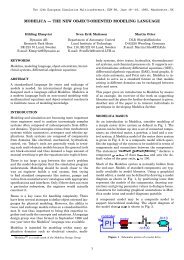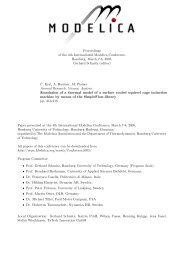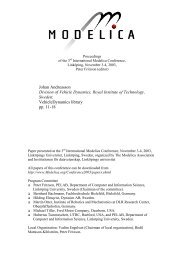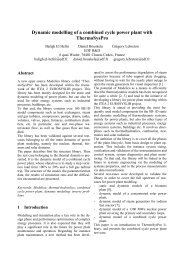Hilding Elmqvist, Hubertus Tummescheit and Martin Otter ... - Modelica
Hilding Elmqvist, Hubertus Tummescheit and Martin Otter ... - Modelica
Hilding Elmqvist, Hubertus Tummescheit and Martin Otter ... - Modelica
Create successful ePaper yourself
Turn your PDF publications into a flip-book with our unique Google optimized e-Paper software.
H. <strong>Elmqvist</strong>, H. <strong>Tummescheit</strong>, M. <strong>Otter</strong> Object-Oriented Modeling of Thermo-Fluid Systems<br />
Region 3: For Re ≥ 4000, the flow is turbulent.<br />
Depending on parameter “from_dp” either of two<br />
explicit equations are used: If from_dp = true<br />
( m & = f1(<br />
pLoss<br />
) ), λ2 is computed directly from pLoss<br />
using λ2 = pLoss/k2. The Colebrook-White equation<br />
(Colebrook (1939); Idelchik (1994) p. 83, eq. (2-9))<br />
1 ⎛ 2.<br />
51 ⎞<br />
= −2<br />
⋅ lg⎜<br />
+ 0.<br />
27 ⋅ ∆⎟<br />
λ ⎝ Re λ ⎠<br />
gives an implicit relationship between Re <strong>and</strong> λ.<br />
Inserting λ2 = λ·Re·|Re| allows to solve this equation<br />
analytically for Re:<br />
⎛<br />
2.<br />
51<br />
⎞<br />
Re = −2<br />
⋅ λ lg<br />
⎜<br />
2 + 0.<br />
27 ⋅ ∆<br />
⎟<br />
⋅sign(<br />
λ2)<br />
⎜<br />
λ<br />
⎟<br />
⎝ 2 ⎠<br />
These are the full-line curves in Figure 4 <strong>and</strong><br />
Figure 5. If from_dp = false ( pLoss = f2<br />
( m&<br />
) ), λ2<br />
is computed by an approximation of the inverse of<br />
the Colebrook-White equation (Swamee <strong>and</strong> Jain<br />
(1976); Miller (1990) p. 191, eq. (8.4)) adapted to<br />
λ2:<br />
λ =<br />
2<br />
⎡ ⎛ 5.<br />
74 ⎞⎤<br />
0.<br />
25 ⎢Re/<br />
lg⎜<br />
∆<br />
⋅ + ⎟⎥<br />
0.<br />
9<br />
⎢ ⎜ 3.<br />
7 Re ⎟⎥<br />
⎣ ⎝<br />
⎠⎦<br />
2<br />
⋅sign(Re)<br />
These are the dotted-line curves in Figure 4 <strong>and</strong><br />
Figure 5.<br />
Region 2: For 2000 ≤ Re ≤ 4000 there is a<br />
transition region between laminar <strong>and</strong> turbulent<br />
flow. The value of λ2 depends on more factors than<br />
just the Reynolds number <strong>and</strong> the relative<br />
roughness, therefore only crude approximations are<br />
possible in this area. A laminar flow up to Re =<br />
2000 is only reached for smooth pipes. The<br />
deviation Reynolds number Re1 at which the<br />
transition region starts is computed according to<br />
(Idelchik (1994), p. 81, sect. 2.1.21):<br />
3<br />
e k<br />
Re1<br />
= 745⋅<br />
k3<br />
= if ∆ ≤ 0.0065 then 1 else 0.<br />
0065/<br />
∆<br />
Between Re1 = Re1(∆) <strong>and</strong> Re2 = 4000, λ2 is<br />
approximated by a cubic polynomial in the "lg(λ2) =<br />
f(lg(Re))" chart (see Figure 5) such that the first<br />
derivative is continuous at these two points. In order<br />
to avoid the solution of non-linear equations, two<br />
different cubic polynomials are used for the direct<br />
<strong>and</strong> the inverse formulation (from_dp = false/true).<br />
This leads to some discrepancies in λ <strong>and</strong> λ2 if ∆ ><br />
0.003 (= differences between the full <strong>and</strong> the dotted<br />
curves in the above Figures). This is acceptable,<br />
because the transition region is not precisely known<br />
since the actual friction coefficient depends on<br />
additional factors <strong>and</strong> since the operating points are<br />
usually not in this region.<br />
The pressure loss equations above are valid<br />
for incompressible flow. According to (Idelchick<br />
(1994) p. 97, sect. 2.1.81) they can also be applied<br />
for compressible flow up to a Mach number of<br />
about Ma = 0.6 with a maximum error in λ of about<br />
3 %. In a wide region the effect of gas<br />
compressibility can be taken into account by:<br />
λ comp<br />
⎛ κ −1<br />
= λ ⋅⎜1<br />
+ ⋅ Ma<br />
⎝ 2<br />
2<br />
⎞<br />
⎟<br />
⎠<br />
−0.<br />
47<br />
where κ is the isentropic coefficient (for ideal gases,<br />
κ is the ratio of specific heat capacities cp/cv). This<br />
effect is not yet included in the pipe friction model.<br />
Another restriction is that the pressure loss model is<br />
valid only for steady state or slowly changing mass<br />
flow rate. For large fluid acceleration, the pressure<br />
drop depends additionally on the frequency of the<br />
changing mass flow rate.<br />
To summarize, the pipe friction component<br />
provides a detailed pressure loss model in pipes in<br />
the form m& = f1(<br />
pLoss<br />
, ∆)<br />
or pLoss = f2<br />
( m&<br />
, ∆)<br />
.<br />
These functions are continuous <strong>and</strong> differentiable,<br />
are provided in an explicit form without solving<br />
non-linear equations, <strong>and</strong> do behave well also at<br />
small mass flow rates. This pressure loss model can<br />
be used st<strong>and</strong>-alone in a static momentum balance<br />
<strong>and</strong> in a dynamic momentum balance as the friction<br />
pressure drop term. It is valid for incompressible<br />
<strong>and</strong> compressible flow up to a Mach number of 0.6.<br />
5 St<strong>and</strong>ard Medium Interface<br />
The main properties of a single substance medium<br />
are described by 3 algebraic equations between the 5<br />
thermodynamic variables pressure (p), temperature<br />
(T), density (d), specific internal energy (u) <strong>and</strong><br />
specific enthalpy (h). In a medium model, three of<br />
these variables are given as function of the<br />
remaining two. For multiple substance media,<br />
additionally nX independent mass fractions X[nX]<br />
are present. For example, if p <strong>and</strong> T are selected as<br />
independent variables besides X, a medium model<br />
provides the algebraic equations<br />
d = d(<br />
p,<br />
T,<br />
X )<br />
u = u(<br />
p,<br />
T,<br />
X )<br />
h = h(<br />
p,<br />
T,<br />
X )<br />
The mass <strong>and</strong> energy balance equations in a device<br />
structurally have the following form for a single<br />
substance medium (see Section 3):<br />
The <strong>Modelica</strong> Association <strong>Modelica</strong> 2003, November 3-4, 2003

















